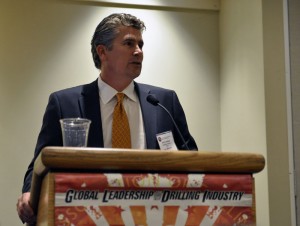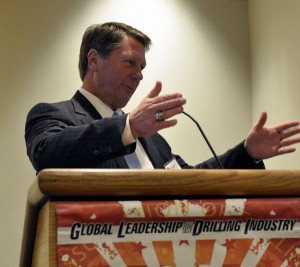Onshore and offshore drilling activity points to active future
By Joanne Liou, editorial coordinator

The 2012 drilling forecast calls for a rising energy demand and healthy commodity prices; however, the positive market trend is accompanied by challenges – most notably the “big crew change” and acquiring competent personnel. John Lindsay, executive VP and COO of Helmerich & Payne, and Mark Burns, senior VP-Western Hemisphere of Ensco, provided views from the land and offshore sides in the drillers outlook session at the 2011 IADC Annual General Meeting in Austin, Texas, last week. Both shared personal and company perspectives that paint an ever-changing and bustling future for the industry.
On the land side, Mr Lindsay noted that the rig count could plateau as new AC drive rigs are not replacing older-style rigs at a one-to-one ratio. “In many cases, you have one rig replacing a rig or a rig and a half to two rigs,” he said.
Well complexity also continues to drive drilling behavior and, without a doubt, unconventional plays are shaping the drilling landscape. “Drilling is getting more difficult. It is more complex. Most of what we do today onshore US is horizontal and directional work,” Mr Lindsay said. “Some of the complexity factor that hasn’t been there in my 25 years in the business, we’re seeing a lot more in multi-well pad drilling in much longer laterals.”
The shift back to oil drilling onshore the US also caught some by surprise. Although oil drilling in the US has traditionally been vertical work and for years has represented only a relatively small part of the overall US land activity, the oil-directed rig count now reflects the continuation of a shift in the market, with oil rig counts continuing to outnumber gas rig counts. “Of course with natural gas price weakness and the oil price strength, you see these (oil and gas directed rig count) lines cross,” he explained. “It wouldn’t surprise me to see these lines cross again sometime in the future depending on the commodity price. A lot of this is directional and horizontal work. It’s not your Plain-Jane, vertical type of activity.”
Mr Lindsay believes there will continue to be an increased focus on more challenging drilling, with vertical drilling steadily decreasing and horizontal/directional drilling on a steady rise. The two types of drilling were equal at one point between 2008 and 2009, an event that he believes will never occur again. “I don’t see a world where we go back to vertical drilling rather than horizontal or directional drilling,” Mr Lindsay said.
In an October 2008 rig count, mechanical rigs accounted for slightly more than half of the US land rig count at 51%, followed by SCR rigs at 34% and AC drive rigs at 15%. Today’s rig fleet paints a shift influenced by well complexity. “AC drive component has increased to 26%, and SCR is flat,” Mr Lindsay said. Essentially, from 2008 to 2011, the number of AC rigs increased by about 67% in three years.
Looking only at US unconventional plays, the growth of the AC drive rig count is even more pronounced. “You can see again mechanical rigs are continuing to lose market share in more difficult drilling environments, which really isn’t a surprise,” Mr Lindsay stated. “I think what we see our customers doing and a lot of operators in general, they’re going to want to drill more and more, and they’re going to increase the size of their fleets in unconventional plays. That’s shaping the landscape.”
Quantitatively, since January 2006, H&P had been building about 2 1/2 rigs per month. Today, H&P is delivering four rigs a month.

In the offshore arena, demand for oil, specifically from non-OECD markets, continues to drive growth. “It goes without saying that the market fundamentals of our industry are very strong right now,” Mr Burns said. “Global oil demand has returned to pre-financial crisis levels, and oil and gas demand will increase by more than 1.4 million bbl/day this year,” he said. Further, by 2013 the demand is expected to be more than 5.0 million bbl/day above the pre-recession peak, according to data from PFC Energy.
The recovery of the US Gulf of Mexico (GOM) deepwater market in addition to an increase in deepwater activity worldwide points to a 20% annual growth in the number of deepwater fields through 2015, Mr Burns explained. More evidence of a promising outlook can also be found in offshore E&P spending, which has returned to 2008 levels, he said.
Referring to growth in Southeast Asia, West Africa, the US GOM and Brazil, Mr Burns said he believes offshore demand both in deepwater and for jackups will continue to experience positive trends. Paralleling the boom in land rig construction, Mr Burns said that more than 140 offshore rigs are under construction around the world, with almost 100 of those ordered just within the past year; most are expected to be delivered in the next two to three years.
Mr Burns commended the industry, both land and offshore, in its safety efforts and for the fact that recordable incidents have been reduced by about half since 1998, although the total number of manhours have more than doubled. “We need to move now toward more systems and process safety,” he said. “We, as an industry, need to ensure that we have good systems in place – risks assessments, job safety analysis, management of change … a lot goes on in an offshore environment, and how we manage that is critical.”
Both Mr Burns and Mr Lindsay addressed the personnel challenge as well. Emphasizing the need for competent personnel, Mr Burns stated that “the industry’s experienced are going to be retiring in the next few years, at a time when transformation of our offshore drilling fleet is in its greatest newbuild period since the 1980s.”
To meet the personnel needs of the industry, Mr Burns called for more nationalization; the work force cannot sustain itself if companies hire only from the countries it always has. “We really need to increase our focus on nationalization. We cannot source and supply people to work on these units from the traditional areas – South Louisiana, South Texas,” he said.





i want drilling safety videos